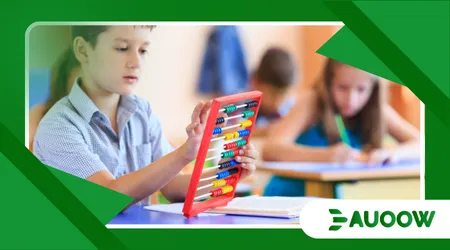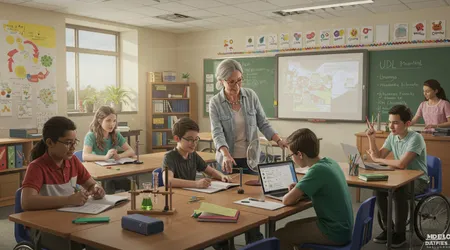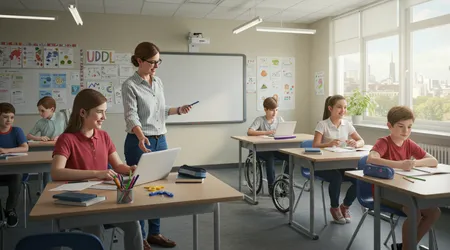How Universal Design for Learning Is Redefining Inclusive Classrooms

The concept of universal design for learning is revolutionizing education by creating classrooms where every student thrives.
In 2025, as schools globally embrace inclusivity, this framework rooted in neuroscience and equity ensures no learner is left behind.
Imagine a classroom where a dyslexic student accesses audio texts, a gifted learner tackles advanced projects, and an English language learner engages through visual aids, all within the same lesson.
This is the promise of universal design for learning, a proactive approach that anticipates diverse needs from the start.
Unlike traditional methods that retrofit accommodations, it embeds flexibility into curricula, fostering environments where all students feel valued.
With technology advancing and educational policies prioritizing equity, universal design for learning is not just a trend it’s a necessity.
This article explores how it’s reshaping inclusive education, backed by real-world examples, data, and practical insights.
The Core of Universal Design for Learning
At its heart, universal design for learning builds on three principles: multiple means of engagement, representation, and action/expression.
These principles, developed by CAST in the 1980s, stem from neuroscience research showing how brains process learning differently.
Engagement taps into students’ motivations, representation offers varied ways to access content, and action/expression allows diverse demonstrations of knowledge.
For instance, a history lesson might include a podcast, a graphic organizer, and a choice between writing an essay or creating a video.
This flexibility ensures accessibility for students with disabilities, cultural differences, or unique learning styles.
Picture a fifth-grade classroom in Seattle where Ms. Carter uses universal design for learning to teach fractions.
She offers a video tutorial, hands-on manipulatives, and a group discussion to engage her students.
A student with ADHD thrives with the tactile tools, while a visually impaired learner benefits from audio descriptions.
++ Inclusion in early childhood education: starting from the beginning
By anticipating variability, Ms. Carter avoids the need for last-minute accommodations, saving time and reducing stigma.
This approach aligns with the 2022 Inclusive Practices study, which found that UDL-based classrooms improved science performance for diverse learners.
The framework’s proactive nature sets it apart from traditional education’s reactive fixes. Instead of modifying lessons for specific students, teachers design with all learners in mind from the outset.
This shift not only enhances accessibility but also fosters a sense of belonging, as students see their needs anticipated rather than accommodated after the fact.

Breaking Barriers with Flexibility
Inclusive education often grapples with barriers like inaccessible materials or rigid assessments. Universal Design for Learning dismantles these by embedding flexibility into lesson design.
Consider a high school biology class where students study ecosystems. The teacher provides text, videos, and interactive simulations, allowing students to choose their preferred format.
Assessments range from written reports to oral presentations, ensuring no student is penalized for their mode of expression. This approach benefits everyone, not just those with disabilities.
Also read: Digital tools for inclusive learning in primary education
In a 2024 study by the National Center on UDL, 78% of teachers reported increased student engagement after implementing UDL strategies.
This statistic underscores the framework’s impact on motivation and participation. For example, in a Chicago middle school, Mr.
Lopez uses UDL to teach literature. He offers digital texts with adjustable fonts, audio narration, and discussion-based activities.
A student with dyslexia reads comfortably, while a gifted peer dives into advanced questions, all within the same lesson.
Technology plays a pivotal role here. Tools like text-to-speech software, interactive whiteboards, and learning management systems make UDL practical.
Yet, the framework doesn’t rely solely on tech simple strategies like offering choice in assignments or using varied instructional methods achieve similar results.
By removing barriers proactively, UDL creates classrooms where equity is the default, not an afterthought.
Flexibility also extends to cultural and linguistic diversity. In a Toronto classroom, Ms. Singh uses UDL to support her multilingual students.
Read more: Inclusive education in practice: stories from teachers and students
She provides vocabulary in English and Spanish, paired with visuals, ensuring English learners engage fully.
This approach not only aids comprehension but also validates students’ identities, fostering an inclusive culture where diversity is celebrated.
Empowering Teachers and Students
Implementing universal design for learning empowers educators to rethink their craft. Teachers move from delivering one-size-fits-all lessons to designing dynamic, responsive curricula.
Professional development is key workshops on UDL equip educators with tools to anticipate learner variability.
In a 2025 ADCET UDL Symposium in Sydney, experts emphasized ongoing training to overcome time constraints and misconceptions about UDL’s complexity.
For students, UDL fosters agency. By offering choices in how they learn and demonstrate knowledge, it encourages self-awareness and independence.
Take Jamal, a 10th-grader with autism in a New York school. His teacher uses UDL, allowing him to present his science project via a recorded video instead of a live speech.
Jamal excels, building confidence in his abilities. This autonomy aligns with UDL’s goal of creating “expert learners” who are purposeful and strategic, as noted by UDL expert Katie Novak.
Teachers also benefit from reduced workload over time. While initial planning requires effort, UDL’s proactive design minimizes the need for individual accommodations later.
In a London primary school, Ms. Patel found that UDL cut her modification time in half, allowing more focus on instruction.
This efficiency highlights UDL’s practicality, addressing concerns about time constraints raised at the 2025 ADCET Symposium.
Moreover, UDL empowers students to advocate for their needs. In a California high school, students in a UDL-based classroom formed a peer-support group to share strategies for accessing content.
This initiative not only built community but also reinforced the idea that variability in learning is normal, reducing stigma around accommodations.
Table: UDL Principles and Classroom Applications
| Principle | Description | Classroom Application |
|---|---|---|
| Engagement | Motivate students through choice and relevance | Offer project options like videos or essays |
| Representation | Present content in varied formats | Use texts, audio, and visuals for lessons |
| Action/Expression | Allow multiple ways to show knowledge | Permit oral, written, or creative assessments |
UDL in Action: Real-World Examples
To grasp UDL’s impact, consider two original scenarios. First, in a rural Georgia elementary school, Ms. Thompson teaches a unit on weather.
She uses universal design for learning by offering a video, a hands-on experiment, and a written guide.
Students choose their path, with some creating digital posters and others recording audio reports. A student with cerebral palsy uses voice-to-text software, thriving alongside peers.
This mirrors UDL’s principle of multiple means of expression.
Second, in a Brazilian urban high school, Professor Silva applies UDL to a civics lesson. He provides texts in Portuguese and English, videos with subtitles, and group debates.
Students can write essays, design infographics, or present orally. An immigrant student from Haiti excels through visual projects, gaining confidence.
This flexibility showcases UDL’s ability to honor diverse backgrounds.
These examples highlight UDL’s versatility across contexts. Whether in under-resourced schools or tech-rich environments, the framework adapts to local needs.
A 2024 ResearchGate study noted UDL’s success in Indian classrooms, where large class sizes and limited resources pose challenges, proving its global applicability.
Another compelling case comes from a Swedish preschool, where UDL shaped sensory-friendly activities.
Teachers offered tactile, visual, and auditory options for storytelling, engaging children with autism and neurotypical peers alike.
This early intervention set a foundation for inclusive learning, demonstrating UDL’s potential across age groups.
The Role of Policy and Technology
Educational policies in 2025 increasingly mandate inclusive practices, amplifying UDL’s relevance.
The U.S. Every Student Succeeds Act and Canada’s Accessible Canada Act emphasize equitable access, aligning with UDL’s principles.
Schools adopting UDL meet these mandates while fostering innovation. For instance, Ontario’s 2025 curriculum guidelines explicitly reference UDL, urging teachers to design flexible lessons.
Technology accelerates UDL’s implementation. Platforms like Google Classroom and apps like Read&Write offer tools for personalized learning.
In a 2025 Australian study, 65% of UDL-adopting schools reported improved outcomes using digital tools.
Yet, technology isn’t a prerequisite UDL thrives with low-tech solutions like choice-based assignments or peer collaboration, ensuring accessibility in resource-scarce settings.
Policy also drives teacher training. In the UK, 2025 funding for UDL workshops has expanded, equipping educators to implement the framework effectively.
This systemic support counters critiques, noted in a 2022 Taylor & Francis study, that UDL requires extensive training to avoid superficial application.
On the tech front, artificial intelligence is emerging as a UDL ally. AI-driven platforms can generate customized materials, like leveled texts or interactive quizzes, in real time.
In a Singapore pilot program, AI-supported UDL classrooms saw a 20% increase in student participation, hinting at future possibilities.
Still, human judgment remains crucial to ensure tech enhances, not replaces, thoughtful design.
Challenges and Solutions
Despite its promise, UDL faces hurdles. Time constraints top the list crafting flexible lessons demands upfront effort.
A 2024 ResearchGate study found 60% of teachers cited planning time as a barrier.
Schools can address this through collaborative planning, where teams share UDL resources, as seen in a successful Minnesota district initiative.
Misconceptions also persist. Some educators view UDL as tech-heavy or overly complex.
Professional development, like the 2025 ADCET Symposium’s hands-on workshops, dispels these myths by showcasing low-tech UDL strategies.
For example, offering students a choice between writing or drawing a response requires no technology but aligns with UDL’s principles.
Resistance to change is another challenge. Veteran teachers may cling to traditional methods.
Peer mentoring, where UDL adopters guide colleagues, has proven effective, as evidenced by a 2024 UK program that boosted adoption by 30%.
This approach fosters buy-in without mandating top-down change.
Finally, assessing UDL’s impact can be tricky. Standardized tests often fail to capture its benefits, like increased engagement.
Schools are exploring alternative metrics, such as student portfolios or self-reflection, to measure success. A 2025 Finnish pilot showed portfolios better reflected UDL’s impact on diverse learners.
A Classroom Like a City Park

Think of a classroom as a city park. A well-designed park has ramps for wheelchairs, benches for rest, and paths for joggers, serving everyone without singling anyone out.
Similarly, universal design for learning creates educational spaces where all students navigate freely. Why shouldn’t every classroom work this way?
By anticipating diversity, UDL ensures no learner is an afterthought, fostering equity and belonging.
This analogy underscores UDL’s universal appeal. Just as parks benefit from inclusive design, classrooms thrive when barriers are preemptively removed.
The framework’s adaptability makes it a cornerstone of modern education, aligning with 2025’s global push for equity.
Conclusion: The Future of Inclusive Education
In 2025, universal design for learning is redefining what inclusive classrooms can achieve. By prioritizing flexibility, equity, and engagement, it ensures every student has a path to success.
From rural Georgia to urban Brazil, UDL’s principles transcend borders, proving that inclusivity is not a luxury but a right.
As policies evolve and technology advances, the framework’s potential will only grow, challenging educators to rethink traditional models.
The journey isn’t without obstacles time, training, and resistance require solutions but the rewards are undeniable: classrooms where all learners thrive.
Let’s embrace UDL not as an option but as the standard, building a future where education truly serves everyone.
Frequently Asked Questions
What is Universal Design for Learning?
It’s an educational framework that promotes flexible, inclusive lesson design to meet diverse student needs, focusing on engagement, representation, and expression.
Do I need technology to implement UDL?
No, while tech enhances UDL, low-tech strategies like offering assignment choices or using varied teaching methods work effectively.
How does UDL benefit teachers?
UDL reduces the need for individual accommodations, saves planning time long-term, and fosters engaging, equitable classrooms.
Can UDL work in resource-scarce schools?
Yes, UDL adapts to any setting with strategies like peer collaboration or choice-based tasks, as seen in Indian classrooms.
Is UDL only for students with disabilities?
No, UDL benefits all learners by addressing diverse styles, backgrounds, and abilities, creating universally accessible education.
